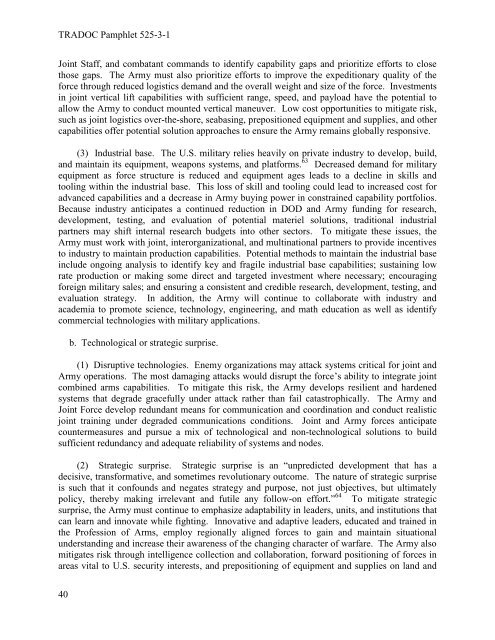TP525-3-1
TP525-3-1
TP525-3-1
Create successful ePaper yourself
Turn your PDF publications into a flip-book with our unique Google optimized e-Paper software.
TRADOC Pamphlet 525-3-1<br />
Joint Staff, and combatant commands to identify capability gaps and prioritize efforts to close<br />
those gaps. The Army must also prioritize efforts to improve the expeditionary quality of the<br />
force through reduced logistics demand and the overall weight and size of the force. Investments<br />
in joint vertical lift capabilities with sufficient range, speed, and payload have the potential to<br />
allow the Army to conduct mounted vertical maneuver. Low cost opportunities to mitigate risk,<br />
such as joint logistics over-the-shore, seabasing, prepositioned equipment and supplies, and other<br />
capabilities offer potential solution approaches to ensure the Army remains globally responsive.<br />
(3) Industrial base. The U.S. military relies heavily on private industry to develop, build,<br />
and maintain its equipment, weapons systems, and platforms. 63 Decreased demand for military<br />
equipment as force structure is reduced and equipment ages leads to a decline in skills and<br />
tooling within the industrial base. This loss of skill and tooling could lead to increased cost for<br />
advanced capabilities and a decrease in Army buying power in constrained capability portfolios.<br />
Because industry anticipates a continued reduction in DOD and Army funding for research,<br />
development, testing, and evaluation of potential materiel solutions, traditional industrial<br />
partners may shift internal research budgets into other sectors. To mitigate these issues, the<br />
Army must work with joint, interorganizational, and multinational partners to provide incentives<br />
to industry to maintain production capabilities. Potential methods to maintain the industrial base<br />
include ongoing analysis to identify key and fragile industrial base capabilities; sustaining low<br />
rate production or making some direct and targeted investment where necessary; encouraging<br />
foreign military sales; and ensuring a consistent and credible research, development, testing, and<br />
evaluation strategy. In addition, the Army will continue to collaborate with industry and<br />
academia to promote science, technology, engineering, and math education as well as identify<br />
commercial technologies with military applications.<br />
b. Technological or strategic surprise.<br />
(1) Disruptive technologies. Enemy organizations may attack systems critical for joint and<br />
Army operations. The most damaging attacks would disrupt the force’s ability to integrate joint<br />
combined arms capabilities. To mitigate this risk, the Army develops resilient and hardened<br />
systems that degrade gracefully under attack rather than fail catastrophically. The Army and<br />
Joint Force develop redundant means for communication and coordination and conduct realistic<br />
joint training under degraded communications conditions. Joint and Army forces anticipate<br />
countermeasures and pursue a mix of technological and non-technological solutions to build<br />
sufficient redundancy and adequate reliability of systems and nodes.<br />
(2) Strategic surprise. Strategic surprise is an “unpredicted development that has a<br />
decisive, transformative, and sometimes revolutionary outcome. The nature of strategic surprise<br />
is such that it confounds and negates strategy and purpose, not just objectives, but ultimately<br />
policy, thereby making irrelevant and futile any follow-on effort.” 64 To mitigate strategic<br />
surprise, the Army must continue to emphasize adaptability in leaders, units, and institutions that<br />
can learn and innovate while fighting. Innovative and adaptive leaders, educated and trained in<br />
the Profession of Arms, employ regionally aligned forces to gain and maintain situational<br />
understanding and increase their awareness of the changing character of warfare. The Army also<br />
mitigates risk through intelligence collection and collaboration, forward positioning of forces in<br />
areas vital to U.S. security interests, and prepositioning of equipment and supplies on land and<br />
40


